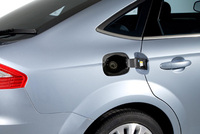Innovative Ford Easy Fuel system counters rising fuel thefts

Ford’s Easy Fuel system which prevents the expensive mistake of misfuelling is also proving a deterrent to petrol and diesel thieves.
The escalating value of fuel has led to thefts from vehicles increasing by 25 per cent in the past year to a reported 4,500 cases in the UK annually.
While Ford Easy Fuel – fitted as standard to top-selling models including Ford Fiesta, Ford Focus and Ford Mondeo – was designed to make refuelling simple and error-free, it also makes syphoning extremely difficult.
“Our novel Easy Fuel feature ensures that Ford owners put the right fuel in their car,” said Andy Barratt, Ford Britain sales director. “Another customer benefit is that it acts as a deterrent by slowing down the fuel thief.”
The technology behind Easy Fuel adds extra layers of security behind the external fuel filler opening, which is anyway secured as part of the vehicle’s central locking, to inhibit forced entry and syphoning.
Easy Fuel’s spring-loaded flap is held closed by two latches that can only be released by a standard-size fuel nozzle. When the proper nozzle is inserted into the filler neck of the system, the latches release and the nozzle pushes the spring-loaded flap to the open position. When the nozzle is removed, the flap is automatically and firmly closed by the spring.
Easy Fuel also has a patented inhibitor designed to prevent improper fuelling and syphoning.
The inhibitor consists of a fuel nozzle detector that guides the nozzle to the opening. If a nozzle or foreign tube of a different size – a diesel nozzle or plastic hose, for example – is placed in the filler neck of a petrol-powered vehicle, the latches will not release. For a diesel-powered vehicle, the inhibitor will keep out the smaller nozzles.
Another deterrent in Ford vehicles stems from its refuelling vapour recovery system. The purpose is to prevent vapours from escaping during fuelling, but syphoning efforts are also thwarted because it closes automatically after the process starts by detecting the pressure of liquid fuel as it passes.



